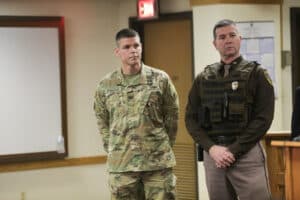The monumental Gila River Indian Community Water Rights Settlement celebrates its 21st anniversary
Corps chose not to publicize environmental damage by DAPL protesters, official testifies
Mary Steurer
North Dakota Monitor

CANNON BALL, ND – FEBRUARY 22: Colonel John Henderson of the Army Corps, left, and Colonel Mike Gerhardt, superintendent of the North Dakota Highway Patrol, attend a press conference as North Dakota Governor Doug Burgum announces plans for the clean up of the Oceti Sakowin protest camp on February 22, 2017 in Mandan, North Dakota. Protesters and campers against the DAPL pipeline, at times numbering in the thousands, are now down to under a hundred. (Photo by Stephen Yang/Getty Images)
A federal official who oversaw land occupied during the Dakota Access Pipeline protests said he tried to put the public on notice about environmental damage by demonstrators, but his superiors said no.
Col. John Henderson, district commander for the U.S. Army Corps of Engineers Omaha District, said during the demonstrations the agency was aware of several environmental concerns, including the improper disposal of trash and human waste that threatened to contaminate the groundwater.
Henderson testified Tuesday he and his team drafted press releases that would have educated people about these issues, but they were not allowed to publish them.
He said the decision was relayed to him through his chain of command, a structure common in military organizations, so he doesn’t know who made the final call. He speculated it was someone several ranks above his head.
“I would say, in essence, we had a professional disagreement,” Henderson said during a trial in federal court in Bismarck.
The protests, which took place in 2016 and early 2017, sought to halt construction of the pipeline, often referred to as DAPL.
Thousands of protesters came to southern North Dakota to show support for the Standing Rock Sioux Tribe, which argued the pipeline intruded on tribal land and could pollute the tribe’s water supply.
Demonstrators camped for months on a combination of federal, private and tribal territory.
The law enforcement response to the protests was primarily coordinated by state and local agencies.
Henderson was called as a witness for North Dakota, which is suing the United States for $38 million to recoup costs it claims it incurred while policing the protests. The state argues decisions made by federal officials, including Henderson, prolonged the protests and inflated expenses ultimately footed by North Dakota taxpayers.
Attorneys for the United States dispute this figure, and say the federal government provided as much help as it had available. The United States also claims that the course of the demonstrations were tied to a litany of other factors, including the popularity of the cause and viral social media coverage.
The bench trial, conducted by U.S. District Court Judge Daniel Traynor, kicked off Feb. 15. Testimony is scheduled to last through mid-March.
Henderson said the Corps did not attempt to enforce compliance with environmental regulations during the protests.
That was primarily because the Corps didn’t have the resources to do so, he continued. According to Henderson, the Corps only had two unarmed park rangers working in the area.
Henderson said he unsuccessfully requested assistance from federal law enforcement several times during the protests.
External
Inspired by her grandparents, Tonah Fishinghawk-Chavez proves that caring for the community is an action, not just a word
Indigenous participation may be highest in the climate conference’s history
Thousands peacefully protest
At an oak savannah near Eugene, Oregon, TEIP interns and elders carry forward a time-honored tradition, restoring meadow health and renewing relationship with the land
Steve Sitting Bear elected as chairman






